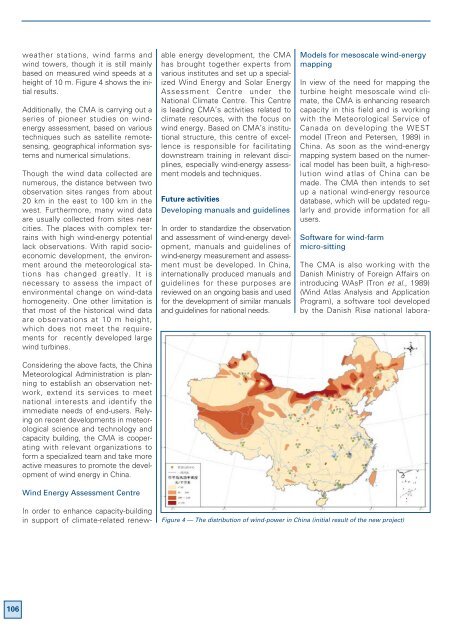Applications of tourism, transport meteorology ... - E-Library - WMO
Applications of tourism, transport meteorology ... - E-Library - WMO
Applications of tourism, transport meteorology ... - E-Library - WMO
Create successful ePaper yourself
Turn your PDF publications into a flip-book with our unique Google optimized e-Paper software.
106<br />
weather stations, wind farms and<br />
wind towers, though it is still mainly<br />
based on measured wind speeds at a<br />
height <strong>of</strong> 10 m. Figure 4 shows the initial<br />
results.<br />
Additionally, the CMA is carrying out a<br />
series <strong>of</strong> pioneer studies on windenergy<br />
assessment, based on various<br />
techniques such as satellite remotesensing,<br />
geographical information systems<br />
and numerical simulations.<br />
Though the wind data collected are<br />
numerous, the distance between two<br />
observation sites ranges from about<br />
20 km in the east to 100 km in the<br />
west. Furthermore, many wind data<br />
are usually collected from sites near<br />
cities. The places with complex terrains<br />
with high wind-energy potential<br />
lack observations. With rapid socioeconomic<br />
development, the environment<br />
around the meteorological stations<br />
has changed greatly. It is<br />
necessary to assess the impact <strong>of</strong><br />
environmental change on wind-data<br />
homogeneity. One other limitation is<br />
that most <strong>of</strong> the historical wind data<br />
are observations at 10 m height,<br />
which does not meet the requirements<br />
for recently developed large<br />
wind turbines.<br />
Considering the above facts, the China<br />
Meteorological Administration is planning<br />
to establish an observation network,<br />
extend its services to meet<br />
national interests and identify the<br />
immediate needs <strong>of</strong> end-users. Relying<br />
on recent developments in meteorological<br />
science and technology and<br />
capacity building, the CMA is cooperating<br />
with relevant organizations to<br />
form a specialized team and take more<br />
active measures to promote the development<br />
<strong>of</strong> wind energy in China.<br />
Wind Energy Assessment Centre<br />
In order to enhance capacity-building<br />
in support <strong>of</strong> climate-related renew-<br />
able energy development, the CMA<br />
has brought together experts from<br />
various institutes and set up a specialized<br />
Wind Energy and Solar Energy<br />
Assessment Centre under the<br />
National Climate Centre. This Centre<br />
is leading CMA’s activities related to<br />
climate resources, with the focus on<br />
wind energy. Based on CMA’s institutional<br />
structure, this centre <strong>of</strong> excellence<br />
is responsible for facilitating<br />
downstream training in relevant disciplines,<br />
especially wind-energy assessment<br />
models and techniques.<br />
Future activities<br />
Developing manuals and guidelines<br />
In order to standardize the observation<br />
and assessment <strong>of</strong> wind-energy development,<br />
manuals and guidelines <strong>of</strong><br />
wind-energy measurement and assessment<br />
must be developed. In China,<br />
internationally produced manuals and<br />
guidelines for these purposes are<br />
reviewed on an ongoing basis and used<br />
for the development <strong>of</strong> similar manuals<br />
and guidelines for national needs.<br />
Models for mesoscale wind-energy<br />
mapping<br />
In view <strong>of</strong> the need for mapping the<br />
turbine height mesoscale wind climate,<br />
the CMA is enhancing research<br />
capacity in this field and is working<br />
with the Meteorological Service <strong>of</strong><br />
Canada on developing the WEST<br />
model (Treon and Petersen, 1989) in<br />
China. As soon as the wind-energy<br />
mapping system based on the numerical<br />
model has been built, a high-resolution<br />
wind atlas <strong>of</strong> China can be<br />
made. The CMA then intends to set<br />
up a national wind-energy resource<br />
database, which will be updated regularly<br />
and provide information for all<br />
users.<br />
S<strong>of</strong>tware for wind-farm<br />
micro-sitting<br />
The CMA is also working with the<br />
Danish Ministry <strong>of</strong> Foreign Affairs on<br />
introducing WAsP (Tron et al., 1989)<br />
(Wind Atlas Analysis and Application<br />
Program), a s<strong>of</strong>tware tool developed<br />
by the Danish Risø national labora-<br />
Figure 4 — The distribution <strong>of</strong> wind-power in China (initial result <strong>of</strong> the new project)

















